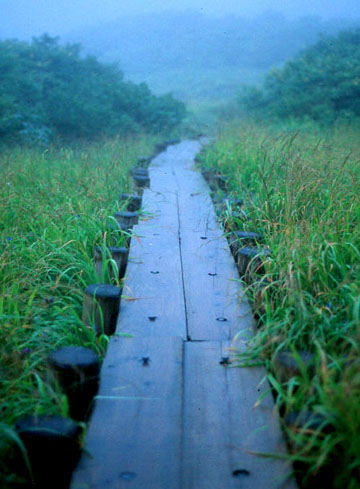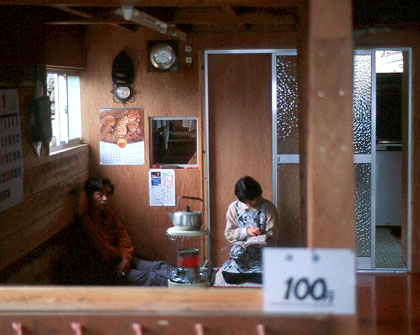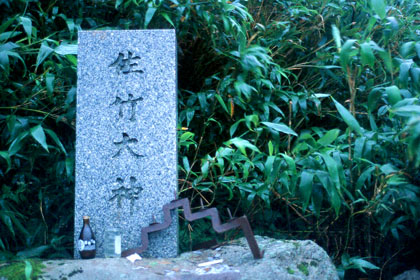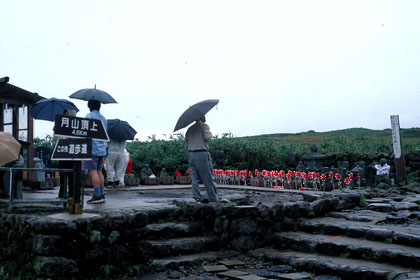|
The din of the rain on the hut roof is loud -- almost deafening at times -- but in the morning there is only fog with no rain. As I look out the window from my sleeping bag I see two ptarmigans emerge nervously from the underbrush. They startle at something and fly away. I pack and get an early start, on the trail at 5:00.
At the junction of the trails to the Yudono-san and Gassan summits there are more stone steps leading up respective ridges. The mist returns, rising from the valley on a gust of cool wind. Every few paces there are small piles of rocks, coins, bits of knotted twine. There is a signpost indicating only .9 KM to Gassan summit. Now it begins to rain, hard. I have a small travel umbrella but the rain is coming from everywhere and nowhere and soon I'm drenched. Itís a hard scramble up the slippery rock steps. Occasionally the mist clears and I see a building near the summit. It looks very close, but in fact the building is quite large so appears closer when viewed through the fog. Finally I reach it, soaked. There is an entrance, but it is locked. No shelter, not even an overhanging roof. I see movement through a window. Soon a middle-aged woman, rubbing sleep from her eyes, unlocks and slides open the door. She waves me inside. It is warm inside. A black and white cat mews at me. A large concrete-floored entrance area (the genkan) has hooks where I hang my wet clothes. I change to a dry shirt and fresh socks, then step up onto the tatami mats and polished hardwood floor of the front room. From the small kitchen area comes music -- a pop station is playing a familiar American folk-rock tune. The woman appears again and asks if I want breakfast. I ask hopefully if she has miso soup. She says yes, and soon a steaming bowl is placed before me. She offers tea and coffee, and more miso soup. She compliments me on my Japanese, but she is a being polite. More tea, more coffee. Through a small opening in the kitchen wall I see a man -- her husband, I guess -- climb down a steep set of stairs. He pulls a pair of pants over his long underwear, then comes out and sits on the floor. He lights a cigarette and stares at the ceiling while he smokes it. After a time he goes outside, then returns with a large plastic jug of kerosene. He fills a space heater and lights it. I ask him if it was cold here last night. He doesn't understand my Japanese and I try again, more carefully this time. He says no, not cold, but it rained a lot. The man lights another cigarette, then goes outside. The cat mews again and wanders close for a scratch. The woman feeds him a few sheets of dried seaweed. I stay for nearly two hours enjoying the warmth, reluctant to venture back out in the rain. Finally I get up and stretch, and don my still-wet sweater and rain jacket. As I'm packing to go the man says something and points out a window. I look; there is an expansive view down the ridge where I had trudged two hours earlier. The mist blows like silk curtains, and we watch a group of pilgrims climbing toward us. I pay for my refreshments and exit. For my tea, coffee and soup I pay a whopping twelve dollars, but I console myself with the knowledge that everything here was either packed in or delivered by helicopter. Considering the winds up here, I decide that a helicopter visit might be a rare thing. At the nearby summit Iím confused by a web-work of trails and unreadable signposts. I walk into the shrine that caps the summit. When I enter under a stone arch I surprise an old priest who is sitting in front of an iron charcoal burner. He lets out a small gasp and almost drops the staff he is carefully branding. I apologize profusely and ask him where the trail to the ninth stage is, pointing at the place-name printed in my trail guide. He leads me to a path that circles around the shrine and points the way. I thank him and go. Between the eighth and ninth stages I step aside as a large group of pilgrims pass on their way up. In the midst of the pack is one lone European, looking a bit bemused as he walks past. He says "Hello" with a German accent and continues on his way. He is wearing the straw hat, baggy white clothes and sandals of a pilgrim. He is tall; I wonder where he found such large footwear. With bells on their feet, most of the younger pilgrims wear hiking boots or Nike sneakers, and wear stylish rain gear over their robes. The older men and women, with sun-weathered faces and strong, muscle-corded hands, wear thin cotton and straw split-toed sandles and have little protection from the rain. They will take three summits on their pilgrimage; Iím impressed. I note with interest that many of the men have shaved their heads, and a few of the women have as well. At the eighth stage, a short hike from the parking lot and bus stop, another group of pilgrims is preparing to leave. A yamabushi priest wears a sky blue long gown, a white cloak with yellow trimming and a peaked hat. He carries a short, flat paddle. He enters a small shrine; a low-toned bell rings out, repeating with greater frequency, then stops. The pilgrims leave, bowing to two women in white who stand in front of the small building near the shrine. The two women walk over to the bench where I have stopped to sit and rest. They suggest that I come in for tea. I sit inside, sipping tea, and listen to the chanting of the priest outside. At intervals there are the sounds of small chimes or cymbals. The wind blows through the bamboo grass, the women quietly bang pots as they clean in the kitchen. Pilgrims come and go... somewhere deep inside the building there is a television, its voice echoing through the tatami halls. Much later, in the evening, I am drinking beer with Kurashige-san in a dark Yokohamo bar. He says, "In this weather only the crazy Yamabushi, the pilgrims, and you will do such kind of thing..." - September, 1998
|



